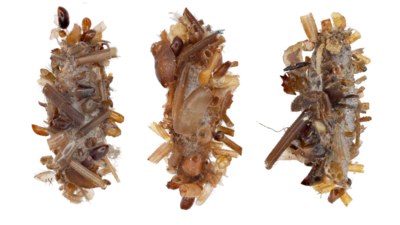Trending
Meet the “bone collector” caterpillar, which wears prey’s body parts as camouflage
Deep within Oahu's forests lurks the "Bone Collector," a carnivorous caterpillar with a gruesome camouflage strategy. This rare creature adorns its silk case with the remains of its insect prey, effectively blending into spider webs where it hunts. Scientists discovered this unique behavior, highlighting the caterpillar's evolutionary adaptation to survive alongside dangerous spiders by disguising itself as discarded debris.
Deep in the forests of Hawaii’s Oahu island lives a creature that seems pulled straight from a horror story: a rare carnivorous caterpillar that not only feeds on other insects but also wears their remains. Nicknamed the “Bone Collector,” this tiny predator takes camouflage to a gruesome new level by covering its silk case with body parts from its prey, blending into its surroundings while avoiding danger.
The chilling discovery, published in the journal Science, reveals an evolutionary rarity that scientists had never observed before. “This behaviour was utterly unknown,” said Daniel Rubinoff, an entomologist at the University of Hawaii at Manoa and lead author of the study. The revelation sheds new light on how little we still know about the hidden predators in our ecosystems.
Why is it called the “bone collector”
Unlike ordinary caterpillars that stick to munching on leaves, the bone collector feeds on insects trapped in spider webs. After its meal, it uses silk to attach pieces of its victims, such as beetle abdomens, weevil heads, and even discarded spider exoskeletons to its protective case.
“It is remarkable that a caterpillar would tie its fate to a spider, a clear and present danger for both caterpillar and moth alike,” said David Wagner, an entomologist at the University of Connecticut who was not involved in the study.
Such behavior is not only rare but highlights the evolutionary tightrope these creatures walk.
Where do the bone collector caterpillars live
The bone collector caterpillar lives in an unusual habitat: spider webs nestled inside tree hollows and rock crevices within a six-square-mile area on Oahu. The webs provide both food and shelter, but residing alongside spiders is a risky lifestyle. To stay safe, the caterpillar blends in by appearing like a pile of leftover insect parts that spiders have already discarded.
Researchers found that spiders never attacked the bone collector caterpillars, suggesting their grim camouflage is working. “These caterpillars can discern differences in objects in their environment,” Rubinoff explained. “They ignore other debris and specifically harvest insect remains to build their casing.” This indicates not just instinct, but a degree of selective awareness rarely seen in such creatures.
A rare and picky predator
The bone collector belongs to the Hyposmocoma genus, a diverse group of moths found only in Hawaii. Many species in this genus create portable silk cases decorated with natural materials like wood or shells. However, the bone collector’s case is far more unsettling.
After careful observation in the lab, scientists discovered that the caterpillar is highly selective about its decorations. Using its mandibles, it examines each potential body part, trimming larger pieces down to size before attaching them to its case. While it’s picky about its fashion, the bone collector isn’t as selective about its meals. It will eat any insects it can catch, even other caterpillars of its kind. This strange blend of vanity and viciousness makes it one of the island’s most bizarre predators.
An endangered lifestyle
Despite its eerie brilliance, the bone collector is incredibly rare. Over 150 field surveys have only identified 62 specimens, and its tiny habitat is under threat from invasive ants and parasitic wasps.
Genetic studies show that the bone collector likely evolved from other carnivorous Hyposmocoma caterpillars more than five million years ago. This was long before Oahu existed, meaning its ancestors probably lived on other Hawaiian islands before relocating.
With its specialised lifestyle and limited habitat, researchers fear this strange species could disappear if conservation efforts aren’t implemented. “Conservation attention is desperately needed to save Hawaii’s endemic arthropods, including its body-snatching caterpillars,” Rubinoff emphasised.
A creepy yet fascinating marvel of evolution
The bone collector’s disturbing habit of wearing its prey highlights just how creative and unsettling evolution can be. This bizarre caterpillar not only thrives in an environment filled with predators but does so by turning its victims into a literal suit of armour.
For now, the bone collector remains one of nature’s most chilling mysteries, reminding us that even the smallest creatures can have the strangest survival strategies. Its legacy may lie not just in what it does, but in how it challenges our understanding of life’s endless adaptations.
Also Read: Why Australia shot dead hundreds of Koalas from helicopters
End of Article
Follow Us On Social Media
Visual Stories
Tired of too many ads?









